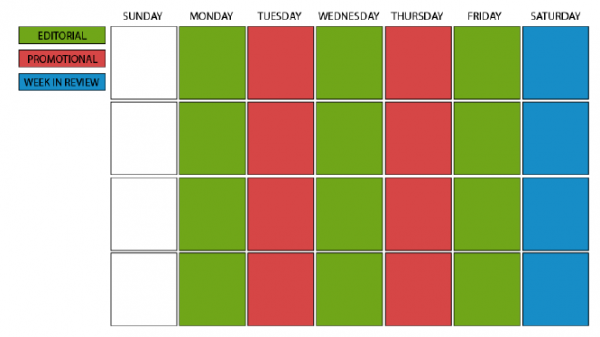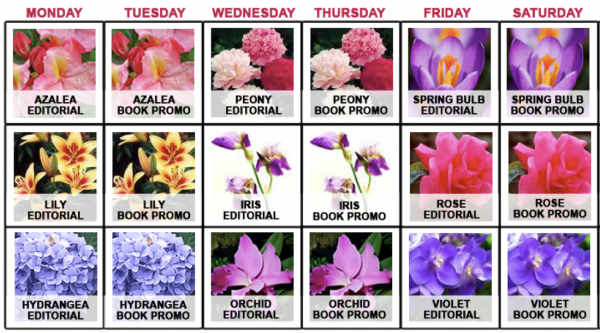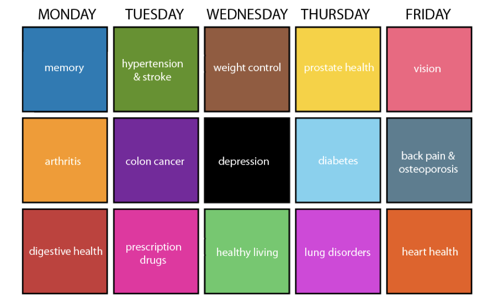
Organize email marketing campaigns by creating an editorial and promotional calendar that keeps editors on track and in line with email revenue goals
It used to be so easy to define an email editorial calendar. There weren’t so many different “types” of email newsletters.
- Email snippet-based newsletter
- Email newsletters with a featured image
- Email newsletters with a featured product hero shot
- Email newsletters with text ads
- Long-form email newsletters
- Short-form email newsletters
- Circulation building promotional emails
- Long-form promotional emails
- Short-form promotional emails
- Text-based sales letter emails
- … the list goes on.
Your website exists primarily to build customer loyalty, to increase your most valuable asset, which is your active email database. For some of our Mequoda System Publishers, email generates 60 to 80 percent of all their revenue.
For reputable copywriters, editors and publishers, email is not just a marketing channel, something that you build and blast.
It’s a tool for building loyalty. It provides frequent, valuable information to users who become enamored with your brand, love your content, and want to buy the other types of information products you sell, or do business with your sponsors.
Using a combination of email newsletters and email promotions will build customer relationships and maximize customer lifetime value. And if you spend the time to write content that people want to read, they’ll be more likely to read, respond to, and even enjoy receiving them.
[text_ad]
Determining an editorial strategy
Begin by creating an email editorial calendar that aligns with your products and sponsorships. The simplest plan works on a one-week cycle.
While the daily tip email newsletter might have a Monday, Wednesday, Friday frequency, the email promotion newsletter might have a Tuesday, Thursday frequency.
Additionally, more than half of the Mequoda publishers with whom we are working have a summary, week-in-review edition of their email newsletter that is delivered on Friday or Saturday.

[text_ad]
The One-Two Punch
One hugely successful strategy we’ve seen in action comes from an interview we did with Jay Schleifer, former Managing Editor of HR Daily Advisor. He explained the “1-2 punch,” their unique approach to email promotions.
Schleifer told us right off the bat that they do not cycle regularly through their entire inventory of products. After much trial and error, HRDA settled on this method: “We promote what sells.”
Schleifer does look for opportunities to sell less popular products but gives a 4-6 week headway between using a product that they know sells less.
Schleifer told us, “The way we do it at the Daily Advisor is that we establish on Monday and Wednesday an issue the industry is having. Then based on that issue, we come in the following day, Tuesday and Thursday with a solution to that problem. If your problem is an HR issue, like that people don’t listen at meetings, then your solution is to have a much more motivational meeting. We ask our editors if we have anything that would help this, and if they tell us ‘yes we do,’ then we offer that product as the solution.”
We mocked this type of calendar up for our fictitious Flora Daily case study and extended it through Friday and Saturday, since we know that B2C publications fare well on the weekends, too. You could certainly mix it up by adding a Week in Review to Friday and a Magazine promotion on Sunday. If Flora Daily had nine main topics, we could reach them all in a period of three weeks using this calendar. We could reach them in four by following HR Daily Advisor’s plan of only using Monday-Thursday for the 1-2 punch strategy.

The Full Cycle
Publishers who have a greater number of products can have two, three and four-week cycles. Johns Hopkins Health Alerts has a three-week publishing cycle to feature all of its 15 products. The baseline sponsors are the Johns Hopkins White Papers.
Some B2B publishers send out 11 email newsletters each week — five email tips, five email promotions, and one-week-in-review summary.
[text_ad]
The Hybrid
Back in September I re-designed our email templates to feature more long-form content and multiple, targeted calls to action. The major change is that each of us have our own templates now. When I send an email, my face is at the top of the email and my bio is in the right rail. Same for Don and Mary. They are the “products” we’re promoting. Since this change, we’ve seen a 3x increase in leads from our daily emails.
We’ve also played a little with our editorial calendar. We used to post five days a week, but decided to bring it back to four days a week and really make every post count.
On Monday, Tuesday, Wednesday and Thursday we send out single-topic emails on Strategy, Magazines, Email and Websites. On Tuesdays we promote our upcoming digital event and on Thursdays we promote our upcoming live event. On Fridays we send out a week-in-review.

What does your email marketing calendar look like? Do you have a method all your own? Share it in the comments!




Wow, Hi Amanda,
Great illustration of an email marketing plan.
I love how you used your graphic to show how simple a email marketing plan can really be. Plus showing a week in review is so kick- butt as an end of week wrap-up for the people who only want to read one compact email is great.
Great work Amanda, looking forward to your future posts.
Thanks for the tips, here, planning is such a big part of successful blogging and marketing, there’s some useful tips here that I’ll have to come back and look at shortly, just bookmarked your post, thanks.
Here’s some things I do when I’m first creating a newsletter for readers, hopefully your readers mind find it useful.
1. Let your readers know how frequently you’ll be sending the newsletter and what they’ll be getting so they are happy when they receive your newsletter each week.
2. Make sure people can find how to sign up for your newsletter easily, you’ll be surprised how many blog owners don’t do this, even some of the big bloggers.
3. Offer Both HTML and Text based newsletters.
I wrote an article on this very topic recently as I’m about to start a newsletter on my blog email newsletter tips